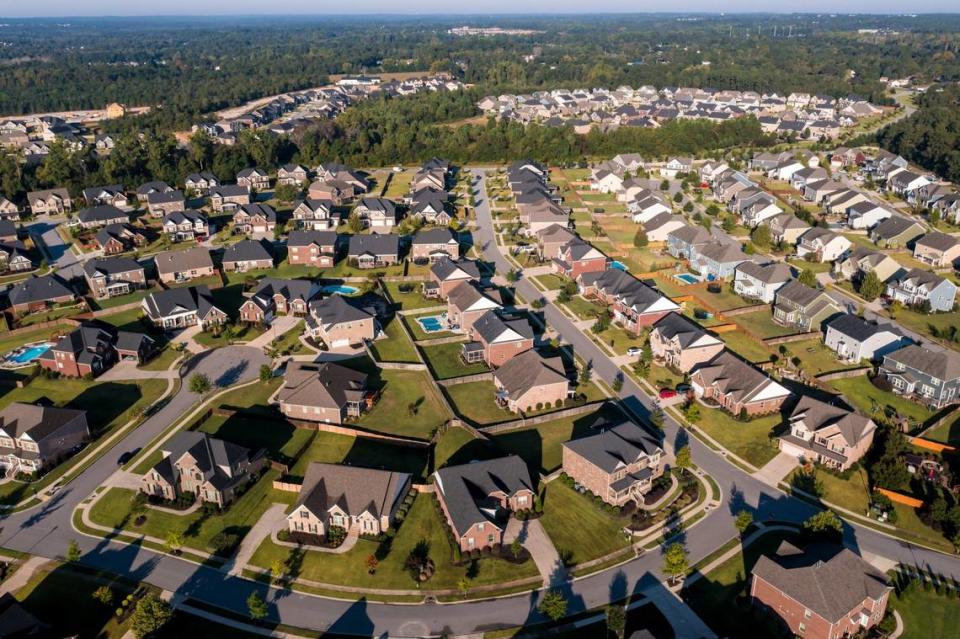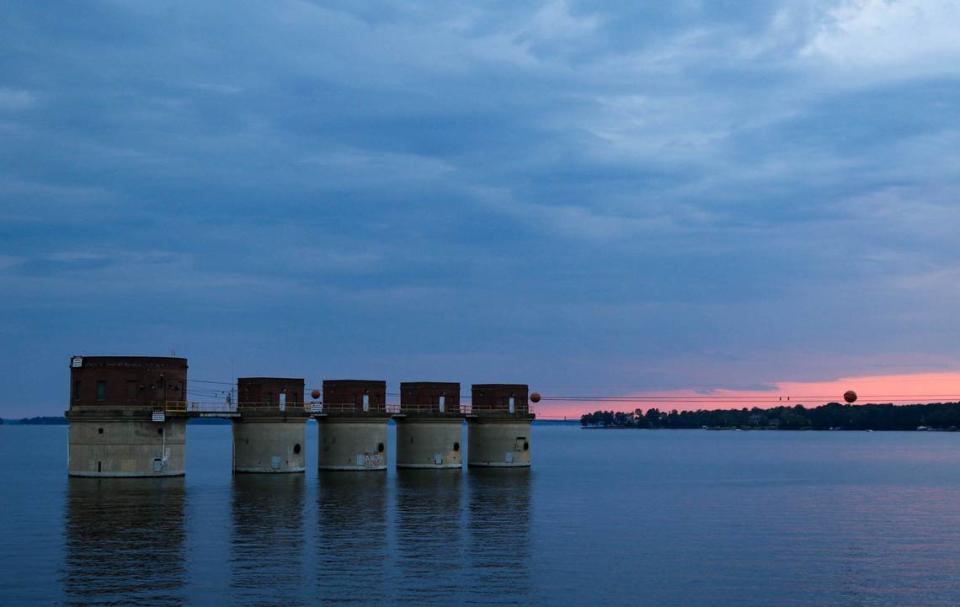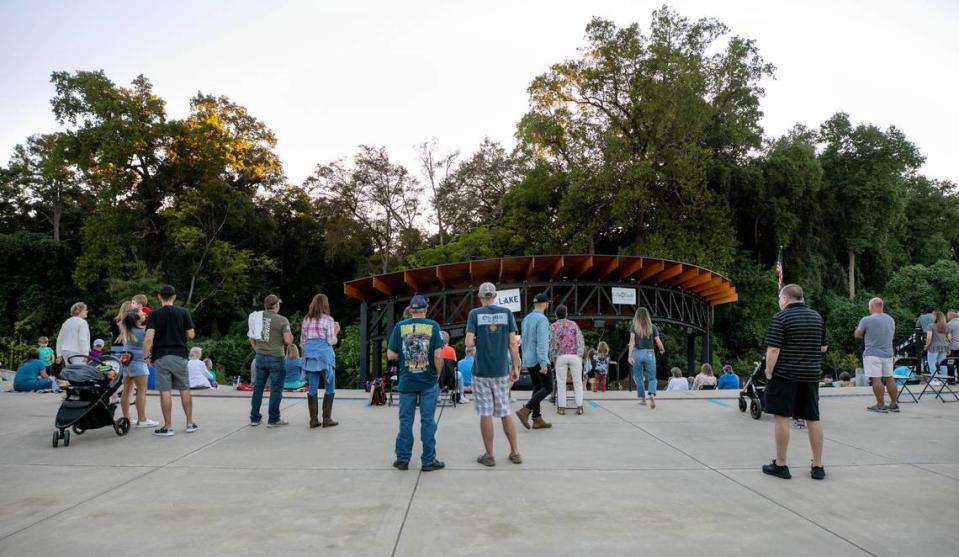As Lexington growth explosion rages on, will it blow up all the things that made it desirable?
When John Knauff moved back home to Lexington in 2012, he returned to a community that had changed since he left 13 years earlier to go to college.
In many ways, it still feels like the same small community he grew up in. But now, the network he maintains through church, his children’s schools and neighborhood groups butts up against other small communities that are taking up more and more space in Columbia’s next-door neighbor.
“I know people can feel overwhelmed by the traffic, the new housing stock, the new schools,” Knauff said. “It used to be people lived in Columbia then moved to Lexington to get out. Now, they move out toward Leesville to get out of Lexington.”
Lexington County is the sixth-most populous county in South Carolina and growing fast. The latest count by the Census Bureau says Lexington County added around 31,600 residents over the past decade, or another town of Lexington plus almost a whole additional Cayce.
That’s a 12% jump in the county’s population in a decade, on top of a 20% rise in 2010 and an almost 30% jump in 2000.
That crush of new residents is driving up housing costs, clogging up roadways and crowding the area’s highly touted public schools. The real estate site Rocket Homes estimated the median listed price for a Lexington County home in August at $289,900 — an almost $10,000 jump from the previous month. That’s in a county where the median wage in 2019 was $32,024 a year, according to the Census Bureau.
When asked what is drawing all those newcomers to Lexington, residents point to the area’s amenities, its quality school system and its small-town feel. But as more people flock here, those upsides are at risk of diminishing. Twenty years from now, will Lexington be able to claim those characteristics at all?
A growing community experiences growing pains, and things are moving so fast that local officials have scrambled to put on the brakes. This year, the county has enacted a freeze on issuing new subdivision permits, citing the strain big new housing developments were putting on public services. The county also has considered an expanded curbside trash pickup service to lighten the load on county collection sites, and a potential stormwater fee for larger developments that create more surface water runoff.
Knauff recognizes that “people from around the country are moving here, because they want to be a part of that.” But he hopes there is a plan for how to handle the boom in housing and traffic without losing what made all those people want to come here in the first place.
It all raises the question: What will this community that sees itself as a small town look like in the coming decades? How big can Lexington get before it loses its core identity?

Lexington is where you want to be
What makes the Lexington area so appealing to Lou Kennedy is that it’s still somewhere anyone can live.
“The fabric of the community runs from farmers to innovators, scientists to homemakers, a little bit of everything,” said the CEO of Nephron Pharmaceuticals. “It’s not too heavy into tech or blue-collar jobs, and I think that makes children more productive, more diverse.”
Nephron Pharmaceuticals is a local success story. Started by Kennedy, a Lexington native, the drug manufacturer’s growing footprint in the Saxe Gotha Industrial Park south of Cayce has made Nephron one of the area’s leading businesses. Kennedy, who grew up in Lexington County, credits that to a strong pro-business environment.
“I’ve told many people this, but our campus got permitted in six short days, which is unheard of,” she said. “In Florida, you’ve got to get an appointment to get the meeting to ask the question. Lexington County is responsive, has lower taxes. ... I can’t tell you anything wrong. Every service is on time and works well.”
Having businesses like Nephron in and near Lexington, Kennedy said, “helps the community in terms of monetary help, and supporting philanthropy.” Kennedy herself is currently serving on the county planning committee.
Nearly a decade ago, in 2012, town leaders created a vision plan for the future of Lexington. Lexington Mayor Steve MacDougall said the goal was to guide the town’s planning and development decisions going forward, so that the town maintains what they feel makes it such an attractive place to live.
MacDougall said part of the town plan was to “have a presence on Lake Murray,” something that will be achieved by plans to build a conference center, for which the town recently received $1 million in state funding.
The vision plan lays out where Lexington’s town limits should be in 20 years, based on the areas served by the town’s water and sewer lines. “Follow those lines, that’s where the border is going to end up,” MacDougall said. “We don’t want to grow more than that.”
Lexington’s water lines currently run between Interstate 20 and communities along Lake Murray, reaching as far east as the Saluda River. Its sewer service stretches out even farther, running west along Augusta Highway, east to Interstate 26 and snaking all along the south shore of the lake.

Instead of growing farther outward, the vision is to have more people living close to downtown Lexington, walking from their homes to shops and restaurants — although the mayor said they don’t want a lot of the apartment construction that has dominated Columbia in recent years.
The town also has an impact fee for new development, so “everybody who comes in the future helps pay for the improvement, not just on the backs of people who have been here,” MacDougall said.
In contrast to the municipal vision, Lexington County Council Chairman Todd Cullum says that despite 20 years on the council, “I don’t know if I can effectively articulate the next 20 months,” he said.
That’s partly because of the speed with which things are changing.
Lexington County is crafting its own comprehensive plan. The county enacted a six-month freeze on any new permitting for multi-unit housing developments, which have sprung up across Lexington County in recent years. The county council also has provisionally approved new building restrictions covering large sections of the county around Lake Murray, as well as protections for more rural parts of the county.
Many county residents were, in fact, adamant about curbing growth when Lexington County Council had a recent public hearing on its planned overhaul of subdivision rules. Dozens of residents spoke out about the impact of over-development on their neighborhoods, commutes and schools. More than 200 others submitted supportive comments ahead of the hearing, agreeing it is past time for the county to curb new development.
But others who spoke worried that limiting new housing construction in some areas would merely push it farther out and raise house prices overall. One speaker pointed out those pushing for limits now are in many cases recent arrivals themselves living in the kind of developments they now want to restrict.
“People move onto the lake and then don’t want anybody moving in next to them,” the man said.

More people, more cars, more traffic
While Cullum expects the county will be able to slow some of the new construction and hold development to a relatively low density, the biggest challenge he sees is one that the county itself can’t address.
“What won’t come out of the (development) moratorium is traffic management and control, because there’s no funding in place to expand” Lexington’s roadways, Cullum said.
The fast-growing county must get more funding from the S.C. Department of Transportation to expand and upgrade roadways, Cullum said.
“We can’t widen an SCDOT road,” Cullum said. “We don’t own the road.”
To get home from his job at Lexington Medical Center, Knauff avoids the downtown portion of Main Street by turning off on Schwartz Road, then taking Parker Street or Railroad Avenue to South Lake Drive, or even following Interstate 20 back home to avoid the bumper-to-bumper traffic that can build up in the middle of town.
“No one drives through there... (because) you drive around the traffic,” said Knauff. “If I don’t want to deal with Lexington traffic, I’ll take some back roads. I do think there are a couple simple projects they can do with downtown that won’t clog up the center.”

Kennedy thinks Lexington County is both a great place to live and run a business. When she travels from the West Columbia headquarters of Nephron Pharmaceuticals to her home on Lake Murray, “I think it’s a great combination to live and work in this county.”
But what she doesn’t enjoy is the journey in between, on roads that are increasingly overtaxed by the county’s growing population.
“We never thought (U.S.) 378 would need to be more than two lanes,” Kennedy said. “Now, if I get home between 5 and 6:30 p.m., it’s bumper-to-bumper traffic. I leave my house at a quarter to 7 every morning. If the intent is for us to have 12-hour work days, it’s working.”
Cullum said he believes the COVID-19 pandemic could reshape some of Lexington’s traffic patterns, as more people can now work from home. He cited an employee of the University of South Carolina who now only goes into the office twice a week.
“If 60% of travel time is now nonexistent, will that measure out as the new basic travel numbers?” he wonders.
Cullum said one area the county wants to look at is incentivizing redevelopment within already built-up areas, rather than pushing new construction out from cities and towns. “There are brownfields in urbanized areas that municipalities could incentivize to redevelop where there is already infrastructure. Why build brand new and run electrical and all that when it’s already existing in another area?”
Kennedy wants to see the state leaders make a bigger push to give Lexington’s roadways more attention. “It’s a great place to live,” she says. “Now help us get there.”
More growth means more services for all those houses
The people in all the new homes going up around Lexington will need other things as well; not just a road to get them home and back, but a water hookup and a good school to send their kids to.
Lexington has already planned for increases in the demand for water and sewer services.
When the town built its current sewer plant, it included capacity to process 12 million gallons a day. The town currently treats about 3 million gallons a day, MacDougall said. Its water services are such an important part of Lexington’s operations — and the town’s revenue — that the mayor said he sometimes feels like he runs a water-and-sewer provider that also happens to include a small town.
“Making those decisions prior to growth is key to not making that a challenge,” MacDougall said. “The challenge of growth is a very good thing for a municipality. Other mayors are thrilled and amazed at the things we’ve been able to do based on the size we are.”
Lexington County has grappled with how best to serve all its new residents. In a county where around half of residents don’t have curbside trash pickup, the county has considered expanding its waste collection program countywide to alleviate the pressure on the few collection sites where residents bring their trash now, despite opposition from some to the new household fees that would come along with the garbage trucks.
One particular perk is fueling new residents’ drive to this particular corner of South Carolina:
“Schools drive it,” MacDougall said. “Schools drive residential growth, which drives business growth. If you do it intentionally, you can manage the growth, and we all help each other. If you just let go willy-nilly, that’s when you discover problems.”
On the north shore of Lake Murray, the Lexington-Richland 5 school district has added one new elementary school to accommodate the growth in enrollment, while Lexington 1 in the central part of the county is also in the process of upgrading its school facilities.
Amid the ongoing population boom, the county is rolling out new housing restrictions before a freeze on new subdivision permits expires in December. Those rules would require more space between houses and more road access points out of a subdivision to avoid spilling all the traffic onto one overburdened road.
Lexington County could also require more open space — up to 50% per development in some parts of the county — and protect certain species of trees from being cut down. All these protections are meant to preserve the rural feeling that attracted many people to the area.
Knauff is supportive of the idea of limiting new housing development, even though he lives in a newer subdivision himself. “You might get less congestion,” he said, “but then you would get more (houses) further out.”

Keeping Lexington the community you want
Kennedy said she believes Lexington can maintain its small-town feel despite the growth of the community. “It’s about people, not geography,” she said.
While Kennedy used to see somebody she knew in every restaurant she went went into, “now I go and I don’t know a single soul, but everybody still holds the door.”
“Like-minded people have found their way here,” she said. “I’m not concerned about us losing that.”
MacDougall said he expects Lexington’s population of 23,568 to double in the next 20 years, although he doesn’t expect that to change the town’s small-town feel.
Angelle LaBorde, president of the Lexington Chamber and Visitors Center, thinks growth can only add to the appeal of the area, especially as new arrivals seek out more amenities and access to Lexington’s natural beauty. She points to all the work done on the greenway along the Congaree and Saluda rivers and the revitalization of Lexington’s Gibson Pond Park.
“I think everybody is focused on community enhancements, and as community demands it, it creates those things,” LaBorde said.
LaBorde also points to the more than 200 new businesses that opened in Lexington in the past year despite the COVID-19 pandemic as proof of the area’s continuing vitality.
To maintain the kind of social diversity Kennedy grew up with, Lexington County needs a diversity in its housing stock.
“If you ride out to the Gilbert area, you’ll see quite a few mobile home communities, but employees in farming don’t make enough for a brick-and-mortar home,” Kennedy said. “If we’re going to preserve the farming element here, we need different types of housing.”
Cullum also sees the growth of the county tied into its small-town and rural character, which appeals to people who are moving out of more urban areas in South Carolina and beyond. He points to the pandemic as sharpening the divide between more traditionally urban areas and Lexington County, which never adopted a mask mandate or other COVID-related restrictions seen elsewhere.
“When you look at where (new Lexington County residents are) coming from, their prior address, most are from Richland County, but there’s also a lot from out west and suburban New England,” Cullum said. “They’re leaving some states that some see as over-restrictive on personal responsibility and personal liberty.”
For Knauff, the changes he’s seen in Lexington don’t outweigh the community he’s found here and he hopes will always be here. He says the growth of the community can bring welcome changes as well as challenges.
When he was growing up, there wasn’t a Target here, for example.
“It’s the same as it’s always been,” he said. “I’ve got some of the same friends I had through high school. There are people in Lexington I’ve known since I was 6. You can still be a part of a smaller community here.”

 Yahoo Movies
Yahoo Movies 
